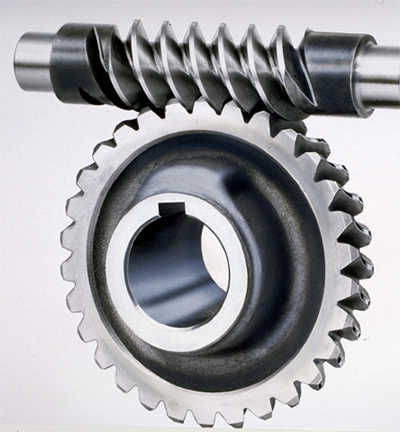 A worm gear is an inclined plane wrapped around a central axle. It is a
gear with one or more teeth in the form of screwed threads.
A worm gear is an inclined plane wrapped around a central axle. It is a
gear with one or more teeth in the form of screwed threads. Worm gears are made of two parts: the pinion and the worm gear. The pinion has small number of teeth and they wrap around the pitch cylinder. The worm gear has concave faces to fit the curvature of the worm in order to provide line of contact instead of point of contact. They are cut helically for better mating Worm gears can provide a high angular velocity between non-intersecting shafts at right angles. They are capable of transmitting high tooth loads, the only disadvantage is the high sliding velocities across the teeth. They provide ultimate power ratio.
Features
The efficiency of worm gear depends on the lead angle, sliding speed, and lubricant, surface quality and installation conditions. They offer smoothest, quietest form of gearing. They provide high-ratio speed reduction in minimal spaces.
Worm gears are used when large gear reductions are required. Worm gear has a unique property of easily turning the gear. The gear cannot turn the worm because the angle on the worm is shallow and when the gear tries to spin the worm, the friction between the two holds the worm in place.
Worm gears work under difficult conditions, presenting unique lubrication demands. The types of oils most commonly used to lubricate worm gears are compounded mineral oils, EP mineral gear oils and synthetics. Operation of the Gear
Worm gear is always used as the input gear. For the operation of worm gear, torque is applied to the input end of the worm shaft by a driven sprocket or electric motor. The worm and the worm shaft are supported by anti-friction roller bearings. Because of high friction worm gears are very inefficient. There is lot of friction between a worm gear and the gear being driven by the worm gear. When used in high torque applications, the friction causes the wear on the gear teeth and erosion of restraining surface.
Types
There are three types of worm gears:
Non throated- a helical gear with a straight worm. Tooth contact is a single moving point on the worm drive.
Single throated- has concave helical teeth wrap around the worm. This leads to line contact.
Double throated- called a cone or hourglass. It has concave teeth both on the worm and helical gear.
Applications
Worm gears are widely used in packaging machinery, material handling, machine tools, indexing and food processing. They are used widely in conveyor systems. They are also used in torsen differential, used on some high-performance cars and trucks. They serve as speed reducers in many different industries.